Menu
Download the accompanying materials to this lesson plan - sign up here
Resources and materials for ESL Kids teachers
Past simple tense verbs come in two forms: regular and irregular, and are used to talk about completed actions in the past. Regular simple past tense verbs are easy to form – you add “ed” to the end of the verb (e.g. I play guitar –> I played guitar).
The past tense simple for regular verbs often has a time reference:
The simple past tense with regular verbs is formed as follows:
In this lesson students will practice using the past simple tense with some common regular verbs.
See our "Warm Up & Wrap Up" page.
1. Teach "today", "yesterday" and "tomorrow"
The lesson is based around what your students did yesterday so we will begin with three important time words.
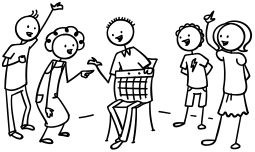 Take a calendar and sit down with your students looking at it … it won't be long before everyone takes an interest in what you are doing. If you have already taught days of the week and months, point to different days and months and ask what they are. You can also ask students to show you on the calendar when their birthdays are, Christmas and other holidays.
Take a calendar and sit down with your students looking at it … it won't be long before everyone takes an interest in what you are doing. If you have already taught days of the week and months, point to different days and months and ask what they are. You can also ask students to show you on the calendar when their birthdays are, Christmas and other holidays.
Next, point at today's date on the calendar and ask, "What day is this?". As well as the actual day (e.g. Wednesday) teach "today". Then point to the days before and after today's date and teach "yesterday" and "tomorrow".
2. Play "Days Rope Jump"
You'll need a length of rope, long enough to lay along the length of your classroom. Lay the rope on the floor and stand facing the rope, so it is horizontal to you. Get all the students to stand on the rope, facing you.
Now demonstrate: jump one step back and shout "yesterday". Jump one step forward onto the rope and shout "today". Then jump one step forward, in front of the rope and shout "tomorrow". Then get everyone jumping, backwards and forwards as everybody shouts together "yesterday – today – tomorrow – today – yesterday – today – tomorrow – today – etc.". Keep going, getting faster and faster until it gets too quick to keep up.
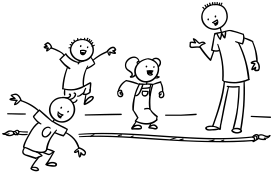 Next, you are going to do the same thing, but the teacher is going to say the days randomly. Everyone has to listen carefully and jump into the correct position according to the day the teacher shouts:
Next, you are going to do the same thing, but the teacher is going to say the days randomly. Everyone has to listen carefully and jump into the correct position according to the day the teacher shouts:
As you do this, try and trick people by saying the same day twice and go at different speeds. As students make mistakes they have to sit out of the game until there is only one left, who is the winner. It’s a really fun game and you can play this a few times.
3. Teach vocab for verbs and the regular past tense form
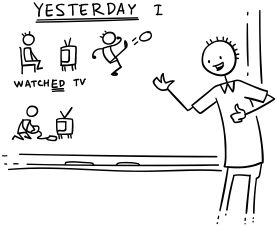 Get everyone to sit down. On the board write "Yesterday, I …". Look like you are thinking and say to yourself "Hmm. What did I do yesterday?". Then draw a few things which you (may or may not) did yesterday, e.g. watched TV, kicked a ball, played a video game, etc. Make sure they are regular verb activities and try and use some from the song. As you are drawing the pictures get students to shout out what they think each one is and write the simple tense form under each picture (watch TV).
Get everyone to sit down. On the board write "Yesterday, I …". Look like you are thinking and say to yourself "Hmm. What did I do yesterday?". Then draw a few things which you (may or may not) did yesterday, e.g. watched TV, kicked a ball, played a video game, etc. Make sure they are regular verb activities and try and use some from the song. As you are drawing the pictures get students to shout out what they think each one is and write the simple tense form under each picture (watch TV).
When you have 3 or 4 pictures on the board take a different colored marker pen/chalk. Underline "Yesterday" and write "ed" onto the end of the verbs (e.g. Yesterday, I watched TV). Then chorus each of the sentences (e.g. "Yesterday, I watched TV").
4. Practice saying past tense regular verbs
Before class, print off as many flashcards as you can for regular verbs. Make sure you include the flashcards for the verbs in the song.
Spread the flashcards out, face up, on the floor or a table and get everyone to gather round. Start off by saying, "Yesterday, I …" and select a flashcard and stick it to the board. Then get each student to pick a flashcard of something they did yesterday and also stick to the board – if you have a small class, get students to choose more cards – try and aim for about 10-15 cards and make sure the cards for the song vocab have been selected.
Your board should now be full of flashcards. Your students will probably know some of the verbs from previous lessons and other words they can now learn. Start by touching one card and elicit or teach the verb with the "ed" ending and write the word under the card. Chorus the word 3 times and then move onto the next card. Go through all the cards, at a brisk pace so no one gets bored.
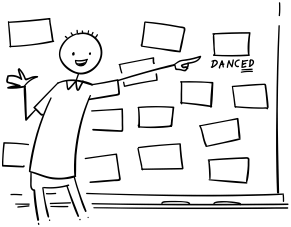 Next, give out the "What did you do yesterday? Survey" worksheet. On each line, get everyone to copy 12 verbs in the past form from the board (e.g. "painted a picture", "watched TV"). This sheet will be used in the next stage of the lesson.
Next, give out the "What did you do yesterday? Survey" worksheet. On each line, get everyone to copy 12 verbs in the past form from the board (e.g. "painted a picture", "watched TV"). This sheet will be used in the next stage of the lesson.
Finally, with all of the cards and words on the board, point at a card randomly and get everyone to shout out the word. Go quickly through all of the words. Then, have everyone close their eyes. Remove a card and erase the word. Then shout "Open your eyes!" and ask the first student who puts their hand up to say what the missing verb is. If correct, that student can come up to the board and remove the next card (while everyone else closes their eyes), say "Open your eyes!" and select the first student who puts their hand up. Continue until all of the cards have been removed from the board.
5. Do the "What did you do yesterday? Survey" worksheet
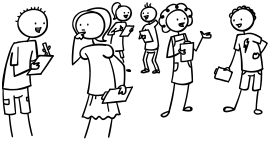 Everyone will have filled in the verbs column of their worksheet from the previous activity. Get everyone to stand up and mingle around the classroom so they can fill in their survey. Be sure to model first so that everyone is clear of what to do. The conversations should be as follows:
Everyone will have filled in the verbs column of their worksheet from the previous activity. Get everyone to stand up and mingle around the classroom so they can fill in their survey. Be sure to model first so that everyone is clear of what to do. The conversations should be as follows:
Student A: Ana, what did you do yesterday?
Student B: Yesterday, I watched TV, played a game, kicked a ball, etc. (Student A circles the corresponding cells in the survey worksheet).
When everyone has completed their surveys, pool the answers to find out which of yesterday’s activities were the most common.
6. Sing "Yesterday was a Great Day!"
The first time you play the song, put up the Yesterday was a Great Day! song poster on the board. Quickly elicit the vocab. Play the song and sing along doing the gestures, as described below in "Gestures and activities for "Yesterday was a Great Day!". Play 2 or 3 times.
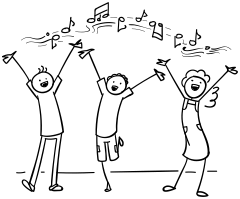 Lyrics for "Yesterday was a Great Day!"
Lyrics for "Yesterday was a Great Day!"
Chorus:
Yesterday, yesterday, yesterday
It was a fantastic day!
Yesterday, yesterday
It was a great day!
Verse 1:
I played with my friends (played!)
I painted a picture (painted!)
I walked in the park (walked!)
I watched TV (watched!).
Yesterday, it was a great day!
Chorus:
Yesterday, yesterday, yesterday
It was a fantastic day!
Yesterday, yesterday
It was a great day!
Verse 2:
I jumped in puddles (jumped!)
I played a game (played!)
I kicked a ball (kicked!)
I danced and danced (danced!)
Yesterday, it was a great day!
Gestures and activities for "Yesterday was a Great Day!"
The gestures are simple and fun to do, matching the verbs in the song.
Chorus:
Verse:
We also have a video that you can stream in class to sing along with (Internet connection required):
7. Read classroom reader "Silly Willy's Great Day"
This reader follows on perfectly from the song and helps to reinforce the new vocab with a fun story. Before class, download and print off the reader "Silly Willy's Great Day". As you go through each page, point to the different things Silly Willy did yesterday and elicit the past tense verbs, as well as eliciting what is strange about each activity he does, for example:
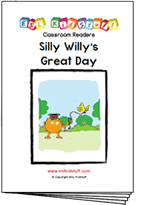 Teacher: (reading from page 2) "What did you do, Silly Willy?" Look at the picture. What did Silly Willy do yesterday?
Teacher: (reading from page 2) "What did you do, Silly Willy?" Look at the picture. What did Silly Willy do yesterday?
Students: He watched T.V.!
Teacher: Yes, that's right. (reading) ... "Well, first of all, I watched T.V.". Good! But what is strange about this? (teacher making confused expression while pointing at the picture)
Students: He watched T.V. upside down!
Teacher: Oh yes! Silly, Silly Willy! (Turning to page 2) ... Oh, look! What else did Silly Willy do yesterday?
Students: He painted a picture!
Teacher: Yes, he did! But look, what happened?
Students: He painted the picture on his walls!
Teacher: Yes, silly, Silly Willy! Look, he even painted over his cat!
etc.
Continue through the story, eliciting the key vocab. Get the students really involved in the story by asking lots of questions (e.g. about the colors and objects on each page).
After reading the story, give out a reader worksheet to each student and read through the story one more time (without stopping for questions, etc.) so students can put the pictures in the order of the story and write the missing verbs. Then go through the answers as a class.
---
Alternatively, watch our video version of the reader (Internet connection required):
8. Play "Past Tense Slap"
This is a very simple activity to conclude the lesson. Put your students into teams. Hold up a verb flashcard everyone have to slap the table if they know the verb. The student who slaps the table first to give his/her answer with the correct "ed" ending wins a point for their team.
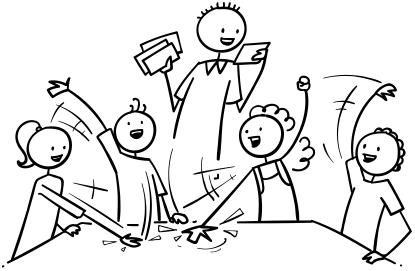
1. Assign Homework: "Past Regular Verbs" worksheet.
2. Wrap up the lesson with some ideas from our "Warm Up & Wrap Up" page.
 Found a mistake?
Found a mistake?
Please let us know
Full access to all resources on ESL KidStuff including lesson plans, flashcards, worksheets, craft sheets,
song downloads, classroom readers, flashcards app and songs app.